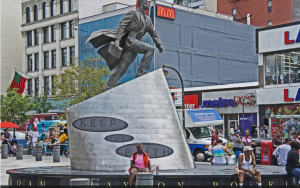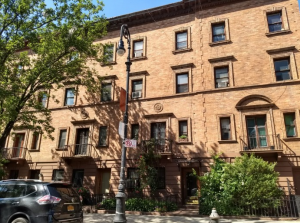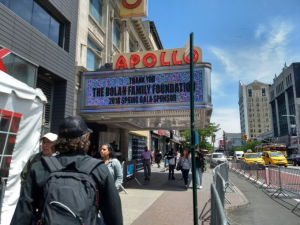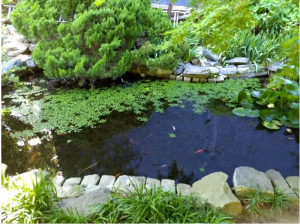Central Harlem: The insider’s guide to living there
Central Harlem was a Dutch village in the 17th century, played a major role in the Revolutionary War, and then, for the next 200 years, existed as a sleepy, sparsely populated stretch of farmland, woods, and rolling hills. Harlem’s bucolic era came to an end at the turn of the 20th century when developers realized there was money to be made in the previously undeveloped tip of the island and began to build housing on spec. Prospective buyers were lured northward with the irresistible promise of suburban-type living combined with an easy commute to downtown.

Since the 1920s, the neighborhood has served as a major residential and cultural center for African Americans who moved northward during The Great Migration. In “Harlem: The Four Hundred Year History from Dutch Village to Capital of Black America,” author Jonathan Gill describes the area then as “a crucible of African-American arts and intellectual development,” a place so vaunted that African Americans “wanted to go to Harlem the way the dead wanted to go to heaven.”
But, as in many neighborhoods in NYC, Harlem is continuously changing. When the 2010 census was taken, 65 percent of the neighborhood identified as black and 12 percent as white. When the next census is taken, those figures are expected to change.
Today’s Central Harlem is a neighborhood of stark contrasts. Some blocks have swagger and a 24/7 vibe; others are almost pastoral. Some look much as they did back in the 20th century, tree-lined with well-preserved brownstones that belonged to a mix of African-American professors, doctors, artists, activists, and musicians. On other blocks, the housing stock has deteriorated or been replaced by multi-story luxury rental buildings and condos. Walk down one block and you’ll see a litter-filled vacant lot, turn the corner and there’s a well-tended community garden with grills, picnic tables, gazebos, and a koi pond.
Last month Harlem preservationists celebrated a victory when the New York City Landmarks Preservation Commission designated the blocks from West 130th to West 132nd Street, Lenox Avenue to Seventh Avenue, as the Central Harlem Historic district. The commission explained that it chose these blocks for landmarking not only because they represent a “significant enclave of residential architecture,” but also because they played such a significant role in the history of the African-American community in the U.S. Here was where the first labor organization led by African Americans—the Brotherhood of Sleeping Car Porters—was established, and where the 1963 March on Washington (an event that spurred the passage of the Civil Rights Act of 1964 and the Voting Rights Act of 1965) was organized.
Chef Marcus Samuelsson, one of the neighborhood’s best-known residents and business owners, describes his neighborhood like this: “Harlem is not a playground for rich bankers and consultants. It’s got students of all colors. It’s got old people who keep the history and tell tall tales.”
Boundaries: West 110th Street on the south, the Harlem River to the north, Fifth Avenue to the East and Morningside, St. Nicholas and Edgecombe Avenues to the West.
Median rent: Two-bedroom, $2,700.
Median purchase price: Two bedroom, $849,000.
Here’s what some Harlem residents want you to know about their neighborhood—where to eat, what to do and what to expect if you’re considering moving there.
Neighbors friendly?
“Harlem is such a friendly neighborhood, which is why I love it. We all seem to know each other. It’s normal and expected to say ‘hello’ and smile at neighbors, even those you don’t know. I like that a lot. I own my own business here —Land Yoga—and it’s an amazing place to have it. There’s so much collaboration and support. It is very special and unusual in New York.” —Lara Land, 37, owns
“I’ve lived here 30 years and love it here—I love the community, the people. Whenever I leave Harlem, I am so glad to come back. I grow vegetables in the community garden on my block— tomatoes, zucchini, beets, and this year I’m trying garlic—and I always give them away to the people coming out of church on Sundays.” —Veronica Jacobs, 63, rents
tomatoes, zucchini, beets, and this year I’m trying garlic—and I always give them away to the people coming out of church on Sundays.” —Veronica Jacobs, 63, rents
“We know the people on our floor but not on the other floors of our building. Maybe that’s because we’re on the first floor so we don’t run into people on the elevator. But, when I walk down the street with my mom and our dog, everyone says ‘hello.’” —Grace Podniesinski, 10
“People are outside all the time. Everyone always says ‘hello—how you doing?’” —Nicole Williams, 37, rents
Transportation is “awesome and great”
“We’ve got all the buses and all the trains you could want. Transportation is awesome and great. But right here is prime for walking. We can walk to just about anywhere we want to go.” —Nicole
“I take the subway—we’ve got the 2, the A, B, and C—when I’m in a hurry. When I’m on my way home and not in a rush, the bus is fine.” —Veronica
“We are so close to Metro North, which is great for visiting the Botanical Garden or heading out to the Hudson area or Connecticut. Right now my stop at 110th Street is closed for construction, but they say it will be back in September.” —Lara
“I use my bike [motorcycle] and park it right outside my house. Finding a parking space for a car up here isn’t too bad either.” —Lloyd Griffin, 52, rents
“I take the train. Faster than the bus—no traffic lights.” —Younis, 30, rents
Tourists come from thousands of miles away
“West 125th Street is the center of the Harlem universe.” —Melissa, 24, rents
“We’ve got great food, movies, churches, and great shopping on 125th Street and West 116th Street. No need to go anywhere else. Harlem is great. There’s no place like it in the world.” —Nicole
“There’s lots to do. 125th Street is like the Times Square of Harlem. I bought this dress there at Old Navy yesterday. The Apollo is there and the Schomburg library is a few blocks from my house. My brother and I took swimming lessons at the Harlem Y.” —Grace

“We are surrounded by parks—Morningside, Central, Marcus Garvey—take your pick.” —Lisa
“I’m blocks from the legendary Apollo Theater, Melba’s, and Sylvia’s restaurants. So many greats come to Harlem to speak and support the rich cultural community. I feel so lucky to have access to that.” —Lara
“My favorite thing to do in the neighborhood is to just sit in the park and read. Sometimes I go to the movies or to the library to use the computers or take out books.” —Melissa, 24, rents
“Lots of people like to shop on 125th Street, but I don’t. I don’t want to look like everybody else. Also, it’s too expensive. I bought a scarf there for $30 then saw it online for $9.” —Veronica
“Most people who come to our museum aren’t necessarily serious jazz fans—they come because they’re curious. Our new location puts us right in the center of Harlem—close to the Apollo, the Studio Museum, Maysles Cinema, and so many churches.” —Loren Schoenberg, senior scholar, the National Jazz Museum in Harlem
A good place to bring up kids? That’s debatable
“There are lots of young families here, lots of parks and libraries. This is a really exciting place to live and bring up kids—I like the diversity and the resources. The problem? The prices. We would like to buy but can’t.” —Meredith, 40, rents
“My son goes to PS 180. He’s doing great. And there are a lot of good charter schools to choose from, too.” —Nicole
“I brought my kids up here. When I first came to Harlem I went to the local clinic to have my kids vaccinated and someone asked me why I didn’t stay in the Caribbean to raise my kids. He thought that would be a better place. Now one of my sons is a nurse. You have to bring up kids the way you want to, no matter where you live.” —Veronica
“I don’t have children, but one of the first things I noticed when I moved here was how filled with children the neighborhood was and continues to be…there are so many services for kids. We have kids yoga at my yoga studio, the JCC has kids activities, there are kids’ gyms, and Harlem Tavern and so many other restaurants are family friendly.” —Lara
“I like to roller skate around the block and see the super pretty brownstones.” —Grace

Eat in or out—plenty of choices
“There aren’t any diners in all of Harlem. We need one. Ponty Bistro is nice to have nearby—it’s lively and the service is decent. Make my Cake is great for birthday cakes. We get most of our groceries from Fresh Direct, but Fine Fare at 145th and Frederick Douglass is pretty impressive. It has some good stuff—natural foods, hippie body-care products—Burt’s Bees kind of things.” —Lloyd
“When I go out I like Amy Ruth’s for the mac and cheese, salmon, and crab cakes. Lighthouse has a good choice of seafood and southern comfort food.” —Nicole
“I usually cook for myself. I like Whole Foods since everything is organic—no greasies.” —Melissa
“I like my food fresh so I like Jacob’s. Especially their banana pudding. For groceries I used to have to walk up to 132nd Street to the supermarket, but now I have a Pioneer right around the corner from me. Much better.” —Lorna
“I go out of the neighborhood for my favorite restaurant, Ricardo Steakhouse across town in East Harlem. It’s been my favorite for a long time. Great drinks, music, food, and atmosphere. Closer to here I like Ponty Bistro.” —Monique Bivens, owns

“Morningside Park and Marcus Garvey Park have Saturday farmers markets, and there’s one on Tuesdays in front of the State Office Building on 125th Street. There’s a beautiful restaurant named Clay that is a bit off the main strip but pays intense attention to their ingredients. I really like that. Lido is another favorite of mine. They have great lunch specials and an awesome brunch, really nice outdoor seating and very consistent quality. I also love Sottocasa for pizza. The owners are so friendly and care so much about every detail. Cafeine is a small, Italian style cafe that’ a really nice place to meet a friend.” —Lara
“I like Jacob’s soul food and its healthy buffet choices. For breakfast, I often go to Sylvia’s for eggs, corned beef hash, and biscuits. The Red Rooster is certainly the high point of Harlem cuisine, and it’s a social center with a great bar too. Chez Lucienne is a local bistro that I’d recommend and the prices are reasonable.” —Lorin
What are Harlemites talking about?
“Diversity is very important here. I’m in tune a lot with the collective effort to keep small businesses alive and make sure that large corporate big-box businesses aren’t ruining our unique flavor. There’s quite a loud ongoing conversation about school and education opportunities for young people. There is also vocal support for the LGBTQ community here in Harlem.” —Lara
“Safety, restaurants, and gentrification are always topics of conversation.” —Monique
Feel safe?
“I always feel safe. Everyone knows me and they watch out for me.” —Veronica
“Do I feel safe? Always!” —Lorna
“I feel as though I see more people on drugs lately and that makes me feel unsafe. Especially by the Metro North station on 125th Street and Park Avenue. Some of the people who hang out there look like zombies.” —Melissa
What advice do you have for anyone thinking of moving here?
“Do your research on the neighborhood. Expect to pay a high rent for a small apartment.” —Monique
“Come because you love rich African-American culture and enjoy being around diversity and learning from it. Care and get involved in this neighborhood because that’s what Harlem is about.” —Lara
“New neighbors need to try to adjust to the neighborhood. Blend in, don’t try to change or adjust it to suit you. We used to have a good old time at barbecues and block parties and Father’s Day events, but lately, there’s been unnecessary monitoring and people calling the cops when it’s not necessary. Be open-minded.” —Nicole

 USA 917-679-1211
USA 917-679-1211






 © Jackson Lieblein, LLC 2015.
© Jackson Lieblein, LLC 2015.
